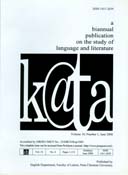Disnarration in Kazuo Ishiguro’s The Remains of the Day
Abstract
ABSTRACT
This study discusses the disnarrated in Kazuo Ishiguro’s The Remains of the Day by focusing on Gerald Prince’s ideas on the disnarrated. According to Prince, disnarration refers to events that have not happened but have been mentioned in the narrative. There are two modes for representing disnarration in the narrative of the novel: implicit and explicit. In the former, the disnarrated is represented by techniques like symbols, metonymies and foil characters. In the later, it is explicitly stated that a particular event could have happened but have not happened. However, based on Ishiguro’s preoccupation with the suppression of meaning, the majority of disnarrated narratives are implicit rather than explicit. The narrator’s implicit remarks signify his lost opportunities for the things he could have. Nearly at the ending of the novel, however, the narrator offers a more honest attitude to the readers by explicitly talking about his regrets and lost opportunities.
Downloads
References
Abrams, M.H. (1999). A Glossary of Literary Terms. Boston: Heinle & Heinle.
Chang, E. (2015) “A Language that Conceals: an interview with Kazuo Ishiguro, author of The Buried Giantâ€. London: 27 March (Unpublished).
Holman, C. H. (1980). A Handbook of Literature. Indianapolis: Bobbs-Merrill Education Pub.
Ishiguro, K. (1993). The Remains of the Day. New York: Vintage Books.
Kelman, S. (1989). “Ishiguro in Torontoâ€. In: Brian, W, Shaffer and Cynthia, F, Wong (eds). Conversations with Kazuo Ishiguro. Mississippi: University Press of Mississippi. 42-51.
Khosravi, S & Barekat B. (2020). “The Suppression of Meaning in Kazuo Ishiguro’s The Remains of the Dayâ€. Language Art, 5(3). 97-114.
Lambrou, M. (2019). Disnarration and the Unmentioned in Fact and Fiction. London: Palgrave Macmillan.
Littlemore, J. (2015) Metonymy: Hidden Shortcuts in Language, Thought and Communication. Cambridge: Cambridge University Press.
Niederhoft, B. (2011). “Unlived lives in Kazuo Ishiguro‘s The Remains of the Day and Tom Stoppard‘s The Invention of Loveâ€. Connotations, 20 (2-3). 164- 188.
Prince, G. (1988). “The Disnarrated.†Style, 22(1). 1–8.
Vorda, A & Herzinger K. (2008). “An Interview with Kazuo Ishiguroâ€. In: Brian, W. Shaffer and Cynthia, F, Wong (eds). Conversations with Kazuo Ishiguro. Mississippi: University Press of Mississippi. 66-88.
Warhol, R. (2005). “Neonarrative; or, How to Render the Unnarratable in Realist Fiction and Contemporary Film†In: James Phelan and Peter J. Rabinowits (eds). A Companion to Narrative Theory. London: Blackwell Publishing Ltd. 220- 231.
--. (2010).‘‘What Might Have Been Is Not What Is: Dickens’s Narrative Refusalsâ€. Dickensian Studies Annual. 41(1). 45-59.

This work is licensed under a Creative Commons Attribution 4.0 International License.
![]() This work is licensed under a Creative Commons Attribution License
This work is licensed under a Creative Commons Attribution License




.png)
.png)

.png)












